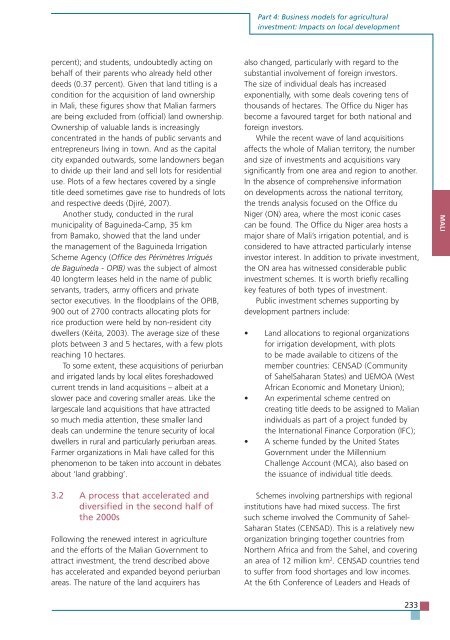TRENDS AND IMPACTS OF FOREIGN INVESTMENT IN DEVELOPING COUNTRY AGRICULTURE
TRENDS AND IMPACTS OF FOREIGN INVESTMENT IN DEVELOPING COUNTRY AGRICULTURE
TRENDS AND IMPACTS OF FOREIGN INVESTMENT IN DEVELOPING COUNTRY AGRICULTURE
You also want an ePaper? Increase the reach of your titles
YUMPU automatically turns print PDFs into web optimized ePapers that Google loves.
percent); and students, undoubtedly acting on<br />
behalf of their parents who already held other<br />
deeds (0.37 percent). Given that land titling is a<br />
condition for the acquisition of land ownership<br />
in Mali, these figures show that Malian farmers<br />
are being excluded from (official) land ownership.<br />
Ownership of valuable lands is increasingly<br />
concentrated in the hands of public servants and<br />
entrepreneurs living in town. And as the capital<br />
city expanded outwards, some landowners began<br />
to divide up their land and sell lots for residential<br />
use. Plots of a few hectares covered by a single<br />
title deed sometimes gave rise to hundreds of lots<br />
and respective deeds (Djiré, 2007).<br />
Another study, conducted in the rural<br />
municipality of Baguineda-Camp, 35 km<br />
from Bamako, showed that the land under<br />
the management of the Baguineda Irrigation<br />
Scheme Agency (Office des Périmètres Irrigués<br />
de Baguineda - OPIB) was the subject of almost<br />
40 longterm leases held in the name of public<br />
servants, traders, army officers and private<br />
sector executives. In the floodplains of the OPIB,<br />
900 out of 2700 contracts allocating plots for<br />
rice production were held by non-resident city<br />
dwellers (Kéita, 2003). The average size of these<br />
plots between 3 and 5 hectares, with a few plots<br />
reaching 10 hectares.<br />
To some extent, these acquisitions of periurban<br />
and irrigated lands by local elites foreshadowed<br />
current trends in land acquisitions – albeit at a<br />
slower pace and covering smaller areas. Like the<br />
largescale land acquisitions that have attracted<br />
so much media attention, these smaller land<br />
deals can undermine the tenure security of local<br />
dwellers in rural and particularly periurban areas.<br />
Farmer organizations in Mali have called for this<br />
phenomenon to be taken into account in debates<br />
about ‘land grabbing’.<br />
3.2 A process that accelerated and<br />
diversified in the second half of<br />
the 2000s<br />
Following the renewed interest in agriculture<br />
and the efforts of the Malian Government to<br />
attract investment, the trend described above<br />
has accelerated and expanded beyond periurban<br />
areas. The nature of the land acquirers has<br />
Part 4: Business models for agricultural<br />
investment: Impacts on local development<br />
also changed, particularly with regard to the<br />
substantial involvement of foreign investors.<br />
The size of individual deals has increased<br />
exponentially, with some deals covering tens of<br />
thousands of hectares. The Office du Niger has<br />
become a favoured target for both national and<br />
foreign investors.<br />
While the recent wave of land acquisitions<br />
affects the whole of Malian territory, the number<br />
and size of investments and acquisitions vary<br />
significantly from one area and region to another.<br />
In the absence of comprehensive information<br />
on developments across the national territory,<br />
the trends analysis focused on the Office du<br />
Niger (ON) area, where the most iconic cases<br />
can be found. The Office du Niger area hosts a<br />
major share of Mali’s irrigation potential, and is<br />
considered to have attracted particularly intense<br />
investor interest. In addition to private investment,<br />
the ON area has witnessed considerable public<br />
investment schemes. It is worth briefly recalling<br />
key features of both types of investment.<br />
Public investment schemes supporting by<br />
development partners include:<br />
Land allocations to regional organizations<br />
for irrigation development, with plots<br />
to be made available to citizens of the<br />
member countries: CENSAD (Community<br />
of SahelSaharan States) and UEMOA (West<br />
African Economic and Monetary Union);<br />
An experimental scheme centred on<br />
creating title deeds to be assigned to Malian<br />
individuals as part of a project funded by<br />
the International Finance Corporation (IFC);<br />
A scheme funded by the United States<br />
Government under the Millennium<br />
Challenge Account (MCA), also based on<br />
the issuance of individual title deeds.<br />
Schemes involving partnerships with regional<br />
institutions have had mixed success. The first<br />
such scheme involved the Community of Sahel-<br />
Saharan States (CENSAD). This is a relatively new<br />
organization bringing together countries from<br />
Northern Africa and from the Sahel, and covering<br />
an area of 12 million km 2 . CENSAD countries tend<br />
to suffer from food shortages and low incomes.<br />
At the 6th Conference of Leaders and Heads of<br />
233<br />
MALI


